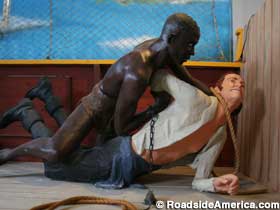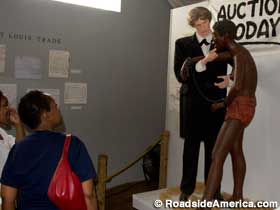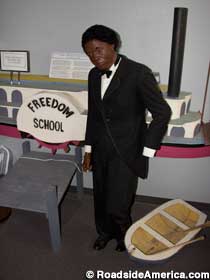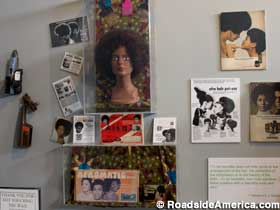
Revolt on the slaver ship.
Griot Museum of Black History
St. Louis, Missouri
Who or what is Griot? It isn't the name of the founder of the Griot Museum; a griot is a West African historian/storyteller. When the museum opened in 1997 it was the Black World History Wax Museum; the name was changed in 2007 to stress its African-rooted history-ness and downplay its waxy-ness.
Yet there's plenty of wax: Griot is the second largest black wax museum in the country, trailing only the National Great Blacks in Wax Museum in Baltimore.

Slave Auction in St. Louis.
The Griot Museum opens in its first gallery with a shock diorama: a life-size cutaway of a Slave Ship. A lower deck no bigger than a crawlspace is packed with dozens of nearly naked figures, chained together (Mostly all that's visible in the gloom is their feet). On the deck above, a manacled African attacks one of his white captors; behind him a boy with no left hand (an apparent mannequin flaw, not an inhuman amputation) screams as he claws his way through the netting so that he can throw himself overboard.
The next exhibit is no happier: a white man in a suit inspects the teeth of a shackled black woman in front of a sign, "Slave Auction Today." Nearby are display cases with a bullwhip, manacles, and a human branding iron. There's also a real cabin, reassembled inside the museum from a former tobacco plantation, rustically furnished with authentic items.
After the harrowing history of slavery exhibits, it's on to the inspirational waxy sections of the museum. Founder Lois Conley, a community organizer by profession, learned the art of sculpting wax and made many of the dummies herself -- and she did a good job.

John Berry Meacham's Freedom School.
"Our primary focus is local," said Griot's deputy director Erika Neal. "But even if some of the people weren't born here or lived here, they probably came here and did something significant."
With that self-imposed St. Louis-region theme, the connection for some of the more famous figures is sometimes thinly stretched. George Washington Carver was born on the other side of the state and rose to fame elsewhere; ditto with Josephine Baker, who spent her girlhood in poverty in St. Louis before becoming a superstar in France. York, member of the Lewis & Clark expedition, is a shadowy historical presence at best. Martin Luther King Jr's connection to the city is that he stopped in St. Louis a few times to plan civil rights strategy with local ministers.
But there's nothing wrong with sprinkling in a few wax superstars to add larger context to the local celebrities, whose lesser-known exploits make the museum unique. Were it not for the mannequins at Griot, visitors likely would never know about John Berry Meacham, who circumvented the law forbidding the education of blacks by teaching them on a boat he anchored in the Mississippi River; or William Wells Brown, an enslaved man unloading a riverboat who just kept walking, for six days, until he was freed in Ohio.

Madam C.J. Walker beauty entrepreneur display.
An entire section of the museum has been set aside for Madam C.J. Walker, beauty entrepreneur and America's first self-made millionairess. "Introduced the hot comb to black women," notes her display, which traces the evolution of hair straighteners and skin lighteners. "Blacks underwent what must have been pure torture."
Modern local honorees include Macler Shepard, whose wax likeness relaxes on a brownstone stoop with a couple of stuffed dogs (He defended and then rebuilt his inner-city neighborhood, an approach that foreshadowed Habitat for Humanity); and Percy Green II, who pioneered job discrimination laws and, in a public protest, climbed 125 feet up the side of the St. Louis Arch (he had a ladder). "Everyone in America should know of Percy Green," said Erika.
The Griot Museum currently has a long list of Missourians considered worthy of inclusion, stymied by the usual roadblocks of limited money and space. But sponsorships are arranged, the community is heavily involved, and the wax population steadily increases. Will they all be as famous as Miles Davis or Dred Scott? Maybe not, but that won't lessen the Griot's efforts to celebrate its local heroes.





